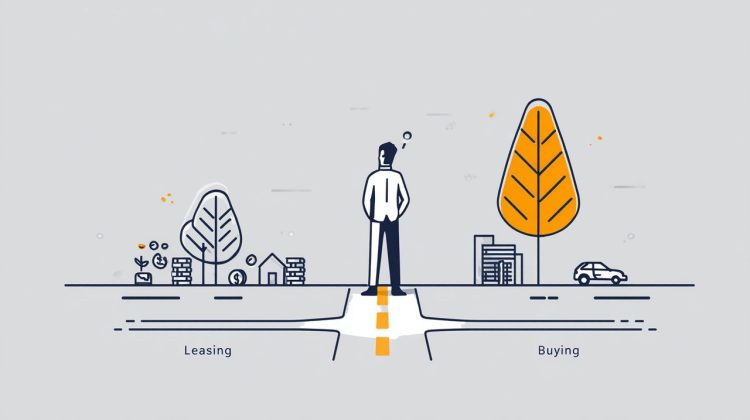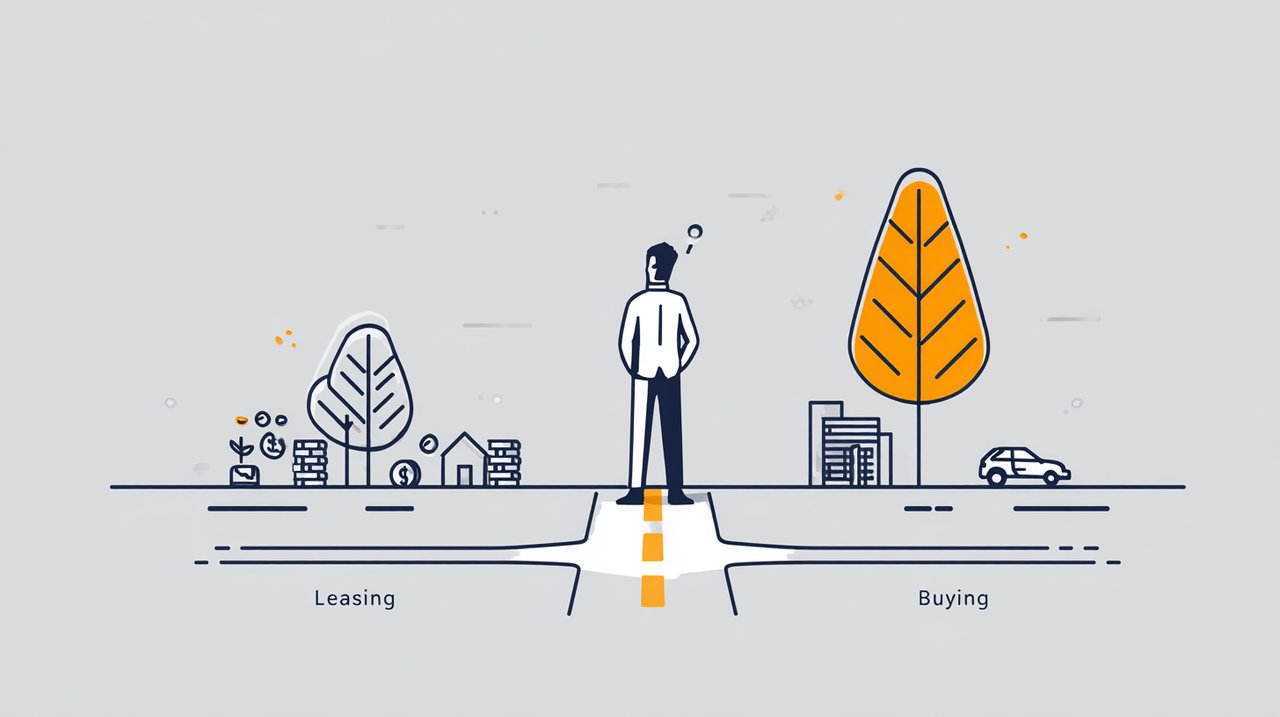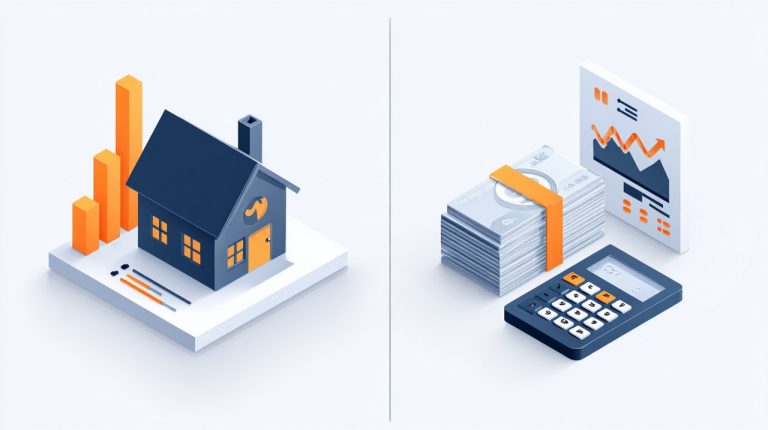As average new car prices are poised to remain above $48,000 and interest rates show no sign of significant retreat into 2025, the perennial question of whether to lease or buy a vehicle has ascended to an unprecedented level of urgency. Consumers now find themselves at a crucial financial crossroads, grappling with a decision that profoundly impacts both immediate affordability and long-term financial well-being. Navigating the intricate landscape of automotive finance demands more than just a cursory glance; it requires a deep understanding of each option’s strategic implications. This comprehensive analysis aims to distill the essential insights, empowering you to make a truly informed choice for your 2025 vehicle acquisition.

Leasing vs. Buying: Core Concepts
Before we can truly dissect the optimal strategy for vehicle acquisition, it is imperative to establish a clear understanding of the foundational distinctions between leasing and buying. These are not merely alternative payment methods, but fundamentally different philosophies of ownership and access, each carrying its own distinct financial architecture and long-term echoes.
Vehicle Ownership Models
At its core, buying a car signifies the acquisition of a tangible asset. You enter into a loan agreement covering the vehicle’s full purchase price, and upon its repayment, the automobile becomes unequivocally yours. This trajectory fosters equity accumulation over time, culminating in the complete liberation from ongoing payments.
Leasing, by contrast, operates more like an extended, specialized rental agreement. Here, your payments are structured around the vehicle’s anticipated depreciation over the lease term, rather than its full market value. When the agreement concludes, you typically return the vehicle, though the option to purchase it at its pre-established residual value often remains.
Key Financial Terminology
To navigate the intricacies of vehicle financing with confidence, a firm grasp of the specialized lexicon is indispensable. These terms are the bedrock upon which any sound decision between leasing and buying must be built.
- Down Payment: This is the initial capital outlay made at the inception of the agreement. Notably, lease agreements typically demand a substantially lower down payment.
- Monthly Payment: The recurring sum remitted to the lender or leasing entity. Lease payments are generally more modest, as they primarily cover the vehicle’s depreciation and associated finance charges over the term, not its entire purchase price.
- Residual Value: A pivotal concept in leasing, this represents the projected market value of the vehicle at the conclusion of the lease term. It directly influences the calculation of your monthly lease payments.
- Depreciation: The inevitable decline in a vehicle’s market value over time. While outright buyers absorb the full impact of this financial reality, lessees are only responsible for the depreciation accrued during their specific lease period.
- Mileage Limits: A critical constraint of leasing, these are the contractual restrictions on the maximum number of miles permitted annually. Exceeding these stipulated limits invariably leads to punitive surcharges.
2025 Market Insights: Leasing Advantages & Buying Considerations
The current automotive market, particularly as we look towards 2025, is characterized by a distinctive confluence of economic forces that profoundly shape the calculus for vehicle acquisition. Factors such as prevailing interest rates, evolving supply chain dynamics, and shifting consumer demand collectively dictate the relative merits of leasing versus buying.
Leasing’s Short-Term Appeal
In an era marked by elevated new vehicle prices, leasing frequently emerges as a more accessible initial pathway to a new car. The inherent benefit of lower monthly payments can significantly enhance one’s cash flow, thereby placing newer, more technologically advanced vehicles within reach for a broader segment of consumers.
For individuals whose primary considerations are minimizing immediate expenditure and enjoying the latest automotive innovations through frequent upgrades, leasing presents an exceptionally compelling proposition in the 2025 market.
Beyond the immediate financial relief, leasing often comes with the added advantage of predictable maintenance costs. Most lease terms are strategically aligned with the manufacturer’s warranty, effectively insulating lessees from unforeseen, substantial repair expenses. This inherent flexibility to transition into a new model every few years holds particular allure for tech-savvy consumers or those whose evolving lifestyles demand regular vehicle updates.
Buying’s Long-Term Value Protection
While the initial financial commitment for purchasing a vehicle is typically higher, this path offers the distinct strategic benefit of asset accumulation. As loan payments steadily reduce the principal, you progressively build equity in the vehicle itself. This growing equity represents a tangible personal asset that can be strategically leveraged for subsequent purchases or as a component of your overall net worth.
The advantages of outright ownership are manifold and profound:
- Unrestricted Mileage: Unlike leased vehicles, buyers enjoy complete freedom to drive as extensively as their needs dictate, unburdened by the specter of mileage penalties.
- Customization Autonomy: Ownership grants the liberty to personalize and modify the vehicle without the anxieties of lease-end inspections or potential charges for alterations.
- Resale Value Capture: Although depreciation is an undeniable factor, possessing the title means you directly benefit from the vehicle’s eventual resale value. For well-maintained models or those with enduring market demand, this can represent a substantial financial return.
Indeed, with the used car market potentially stabilizing after a period of considerable volatility, the traditional strength of buying’s long-term value proposition could see a resurgence in 2025, especially for models renowned for their robust residual values.
Decision Framework: Personal Finance & Lifestyle Match
Ultimately, the quest to identify the “smarter” choice between leasing and buying a car in 2025 transcends generalized advice. It demands a highly personalized assessment, meticulously aligning the decision with one’s unique financial health and daily lifestyle. There exists no singular, universally superior option, but rather a spectrum of choices, with the optimal path being the one that most precisely harmonizes with your specific circumstances and aspirations.

Financial Situation Deep Assessment
Your individual financial profile serves as the paramount determinant in this critical decision. A rigorous self-assessment across several key metrics is indispensable for clarity.
- Budget & Cash Availability: Evaluate your capacity for an upfront investment. Can you comfortably manage a substantial down payment for a purchase, or do the typically lower monthly lease payments better accommodate your budgetary constraints?
- Credit Score: A robust credit score, generally above 700, is fundamental for unlocking the most favorable interest rates on both loan and lease agreements. For those with a less established credit history, the reduced monthly commitments of a lease might appear more attractive.
- Debt-to-Income Ratio: Scrutinize how a new vehicle payment will integrate into your existing financial obligations. A lease, with its often lower monthly burden, may initially exert less pressure on this crucial ratio.
To illustrate, if a significant down payment is within your means and the long-term objective is tangible asset accumulation, purchasing often presents itself as the more advantageous route. Conversely, if the preservation of immediate cash flow and the minimization of monthly expenditures are your guiding priorities, leasing undeniably holds a distinct appeal.
Driving & Usage Habits Consideration
Beyond the purely financial calculus, your daily driving patterns and anticipated vehicle usage must also be factored into this pivotal decision. These practical considerations can significantly tip the scales.
- Annual Mileage: For drivers who consistently exceed 12,000 to 15,000 miles annually, leasing swiftly becomes economically punitive due to severe over-mileage penalties. Ownership, in stark contrast, offers the invaluable freedom of unlimited mileage.
- Appetite for New Technology: If you possess a keen desire for the cutting-edge in safety features, advanced infotainment systems, or the latest electric vehicle innovations, leasing provides a structured pathway to frequent upgrades, keeping you at the forefront of automotive technology.
- Vehicle Wear and Tear: Individuals who anticipate subjecting their vehicle to considerable wear or envision extensive modifications will find greater latitude with outright ownership. This path mitigates the concerns associated with stringent lease-end inspections and potential charges for alterations.
First-Time Buyers: Leasing vs. Buying Deliberation
For those embarking on their inaugural vehicle acquisition, the choice between leasing and buying can appear particularly formidable. This demographic frequently confronts a distinct set of challenges, including the imperative of establishing credit, navigating initial financial outlays, and anticipating an uncertain future. Consequently, strategic, well-informed guidance becomes not just helpful, but absolutely crucial.
Leasing often presents an attractive entry point for first-time buyers, primarily due to its lower initial outlay and more manageable monthly payments. This pathway can offer a practical means to drive a reliable, new vehicle while simultaneously cultivating a positive payment history. However, a critical caveat remains: leasing, by its very nature, does not contribute to asset equity.
First-time buyers are thus faced with the delicate balancing act of reconciling immediate affordability with their overarching long-term financial aspirations when making this significant car acquisition decision.
Conversely, purchasing, despite demanding a more substantial upfront investment and higher monthly commitments, confers the profound benefit of asset ownership. Over time, the vehicle transforms into a tangible asset, a foundational component of one’s net worth. For young professionals or individuals strategically planning for enduring financial stability, this represents a significant and empowering step.
Two additional considerations are particularly pertinent for this group:
- Credit Building: Both leasing and buying can serve as effective mechanisms for building credit. However, the specific impact can vary depending on whether the credit established is installment-based or revolving, and the overall size of the loan or lease.
- Future Planning: It is prudent to anticipate potential life transitions, such as career changes, family expansion, or improvements in credit standing. Outright ownership inherently provides greater flexibility for selling or trading the vehicle should circumstances evolve.
Final Choice & Future Trends Outlook
The ultimate determination in the lease-versus-buy dilemma for 2025 is not a matter of universal decree, but rather a deeply personal one, intricately woven into your individual financial blueprint, lifestyle demands, and core values. There is no universally “smarter” move, only the most suitable one that resonates with your unique situation.
If your priorities lean towards minimized monthly payments, the allure of frequent vehicle upgrades, and a desire for minimal maintenance concerns, then leasing undoubtedly presents itself as the optimal trajectory. Conversely, if the long-term vision encompasses outright ownership, the strategic accumulation of equity, unbridled customization freedom, and the peace of mind that comes with unlimited mileage, then purchasing will almost certainly serve your interests more effectively.
Looking beyond the immediate horizon of 2025, the automotive landscape is poised for profound and continuous evolution. The accelerating ascendancy of electric vehicles (EVs), the proliferation of increasingly sophisticated subscription services, and the expansion of innovative shared mobility platforms are collectively diversifying the very concept of vehicle access. These nascent trends are not merely alternative options; they are fundamentally reshaping the calculus that underpins traditional leasing and buying, potentially redefining what constitutes the “smarter move” for future generations of drivers. As these models mature and gain widespread adoption, they will inevitably necessitate fresh analyses and a continuous re-evaluation of established paradigms.
Therefore, to navigate this complex decision with genuine clarity, we return to our initial crossroads: rigorously assess your current financial standing, project your driving habits with candid honesty, and deeply consider your long-term vehicle needs. Engaging with a trusted financial advisor or an automotive finance specialist to secure personalized quotes and discuss the granular impact of specific market conditions on your chosen path remains an invaluable final step. The “smarter move” is not found in a static rule, but in dynamic, informed self-assessment.
💡 Frequently Asked Questions
Buying a car signifies acquiring a tangible asset through a loan covering its full purchase price, leading to ownership and equity accumulation. Leasing, in contrast, operates like an extended rental agreement where payments are structured around the vehicle's anticipated depreciation over the lease term, with the vehicle typically returned at the end.
Leasing frequently offers lower initial outlays and more modest monthly payments, which can significantly enhance cash flow and make newer vehicles more accessible. It also often comes with predictable maintenance costs, as lease terms align with manufacturer warranties, and allows for frequent upgrades to new models.
Buying a car provides the distinct strategic benefit of asset accumulation and equity building over time. Owners also enjoy unrestricted mileage, the autonomy to customize their vehicle, and the ability to directly benefit from the vehicle's eventual resale value.
The decision should be based on a personalized assessment of your financial situation (including budget, cash availability, credit score, and debt-to-income ratio) and your driving habits and lifestyle (such as annual mileage, desire for new technology, and tolerance for vehicle wear and tear).








